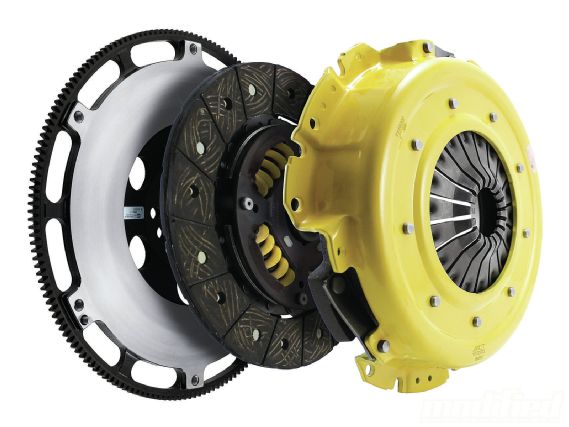 In The Clutch - Tech Talk
In The Clutch - Tech Talk
If you’ve ever replaced a clutch, then you know it’s a big job. Dropping the transmission out of most cars is both time consuming and physically taxing, given how heavy and awkward transmissions are to handle. Having done more than my fair share of clutch swaps over the years, a few especially memorable ones involving seized bolts and bloody knuckles, I think it’s reasonable to say this is a job few of us look forward to.
 |
Here you can see how the clutch system stacks up, with the disc (middle) being pushed (or pulled, depending on the design) against the mating surface of the flywheel (left) and the pressure plate (right) to link the engine to the driveline.
|
Here you can see how the clutch system stacks up, with the disc (middle) being pushed (or pulled, depending on the design) against the mating surface of the flywheel (left) and the pressure plate (right) to link the engine to the driveline.
As a result, many enthusiasts tend to overlook the importance of the clutch system, both in terms of delivering power to the ground and doing so reliably for thousands of gear changes and the occasional burnout or clutch kick. But when you think about it, few components play a more crucial role than the clutch, since it connects the engine to the driveline, and without this connection you have no forward motion. I don’t know about you, but I like forward motion, especially when it involves tire smoke and the sound of the engine bouncing off the rev limiter.
Before delving into some of the insights provided by Advanced Clutch Technology’s product manager Richard Weiser, let’s quickly recap how a clutch works.
At its most basic level, a clutch is a friction-based device used to connect two rotating shafts. In the case of a combustion engine, the clutch allows the engine’s crankshaft to be mated to the transmission and the driveshafts that send power to the drive wheels. For this mating to happen smoothly, the clutch disc is squeezed between the flywheel on the engine side and the pressure plate on the transmission side, the friction material on the clutch disc allowing just enough slip that the speed of the engine and the speed of the driveline synch up smoothly.
As Weiser from ACT explained, there are five main components to a clutch disc, each delivering important performance characteristics. “Using premium friction materials with steel-backed linings like we do at ACT has multiple benefits. The discs achieve a higher heat tolerance and faster recovery from overheating as well as higher burst strength. The ability to recover faster from overheating also improves the life of the disc. Drive plates also play an important role by providing different amounts of cushioning in between the friction materials. These need to be carefully selected for specific applications, and when done right, [they] result in good engagement characteristics while allowing for quicker engagement and faster shifts. Our retainer plates are made of a thicker, precision-stamped and heat-treated material that helps resist wear and increases strength, while the torsion springs reduce initial driveline shock and absorb torsional vibrations for quieter operation. Finally, the hub is designed to interface with the transmission input shaft, and in our case, we carefully broach the splines in the hub to ensure an exact fit for longer spline life and better clutch release.”
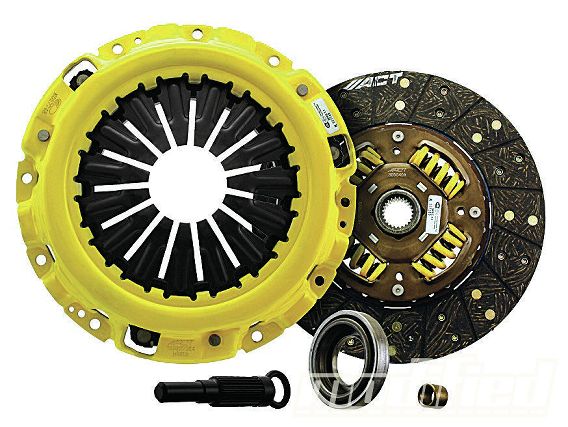 |
A full-faced street disc and pressure plate like this will provide the best street manners, and ACT’s Performance Street line is SFI certified, so you know it can take a beating at the track, too.
|
A full-faced street disc and pressure plate like this will provide the best street manners, and ACT’s Performance Street line is SFI certified, so you know it can take a beating at the track, too.
With respect to choosing the right friction material for your application, Weiser had this to say: “In general, as friction goes up, so does wear rate and harsh engagement. Organic friction materials (similar to OE) offer the smoothest engagement quality and most versatility with the least amount of trade-offs. Our cera-metallic (puck) friction materials have a high heat capacity but result is a harsher engagement and reduced life if driven on the street. Sintered iron materials have the highest torque capacity and heat capability, but they have the harshest engagement and are very heavy.”
The other half of a clutch kit is the pressure plate, which is where the clamp load or static pressure of the system is set. Clamp load is the amount of pressure exerted by the pressure plate ring on the clutch disc when the clutch is engaged. The higher the clamp load, the greater its torque-holding capacity before the clutch begins to slip. The problem with high-clamp-load pressure plates is that they increase clutch pedal effort, meaning your left leg is going to get a serious workout. Not a good scenario for a daily driver, but totally acceptable for a weekend toy or race car.
According to Weiser, there are two ways to gain clamp load: “Changing the geometry or leverage ratio of the pivot points is the first way, and utilizing a stronger diaphragm spring the second. While most manufacturers simply change the geometry of the pressure plate, ACT usually uses a combination of both methods to ensure the best performance. ACT also has the ability to engineer and manufacture our own diaphragm springs and use this technology in many of our pressure plates in order to increase the clamping force while maintaining the proper geometry. While many times this does result in a heavier pedal effort, it is not overbearing and prevents other trade-offs. The driver will benefit from higher torque capacity, longer clutch life, more predictable feel, and better release than a design that uses a stock diaphragm spring and simply changes the geometry of the pivot points.”
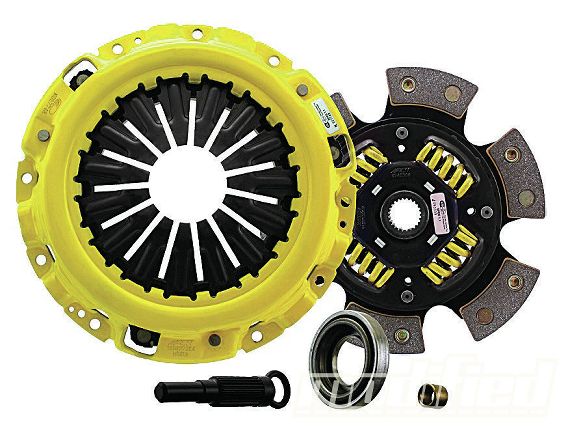 | A sprung six-puck clutch will provide quicker shifts and more aggressive clutch engagement while still maintaining a degree of street-friendliness, whereas a solid four-puck clutch delivers even quicker shifts but at the expense of noise and ease of engagement.
| A sprung six-puck clutch will provide quicker shifts and more aggressive clutch engagement while still maintaining a degree of street-friendliness, whereas a solid four-puck clutch delivers even quicker shifts but at the expense of noise and ease of engagement.
When it comes to selecting the right clutch kit for your needs, there really is no magic formula according to Weiser. “It really depends on a combination of factors, such as how much power the engine produces, what you are using the vehicle for, and individual driving style and preferences. If the vehicle is driven daily and you are consistently driving in stop-and-go traffic and thus need to have a smooth engagement of the clutch, then we would recommend you stick with our Performance Street disc as long as the combination of disc and pressure plate is rated to hold more power than your engine makes. If the pressure plate and disc combination is not rated high enough, we recommend a higher clamp-load pressure plate be used before considering a puck-style disc. If the vehicle is a high-torque-producing weekend warrior that will not see traffic often, is used at the dragstrip or racetrack, and you’d like lightning-quick engagement, then a spring-centered, six-puck disc is a good option. If your vehicle is an all-out race car and you need to shift as quickly as possible to keep lap times down or get to the end of the strip in less time than the competition, then a four-puck rigid hub disc may be right for you. Of course there are trade-offs to every design. For example, the driver should be aware that a four-puck disc will not handle as much slippage as a six-puck disc and that a solid hub will wear the splines faster than a spring-center disc.”
When choosing a pressure plate, Richard recommends that you stick with the same manufacturer as the disc, as they’re normally designed to work together. “We also recommend you choose a kit based on the torque capacities listed for it rather than relying solely on its clamp-load rating. It’s vitally important to match the proper clutch system with the vehicle and its intended use—I cannot stress this enough! We have NMRA racers, for example, who require just the minimum torque capacity needed so they can reduce wheel spin off the line. On the other hand, drifting quite often requires a more aggressive clutch to create wheel spin by a quick clutch kick.”
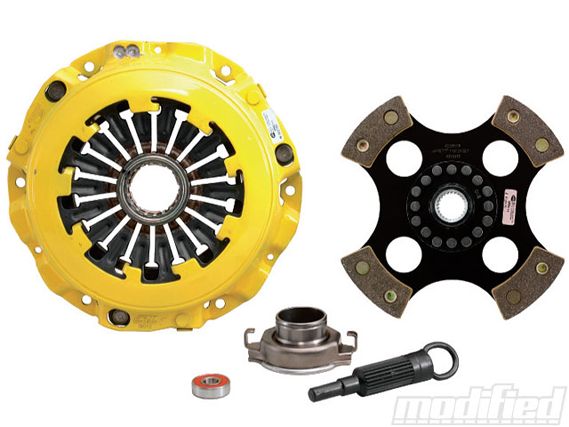 | In The Clutch - Tech Talk
| In The Clutch - Tech Talk
Having “overclutched” a few of my own cars in the past, ending up with a heavy clutch pedal and twitchy engagement that can lead to embarrassing stalls in the Home Depot parking lot, it’s worth emphasizing that you really do not want a heavier-duty clutch kit than your engine’s torque and intended use requires. Nor do you want to use some cheap, off-brand clutch, as I’ve made this mistake and ended up having to replace it far sooner than expected (which brings me back to my opening remark about how un-fun doing a clutch swap is).
So do your homework on disc design and friction material as well as pressure plate clamp load and torque rating, buy enough clutch for your needs but don’t go overboard, and spend your money on a high-quality kit from a brand with a proven track record and a rigorous R&D process.
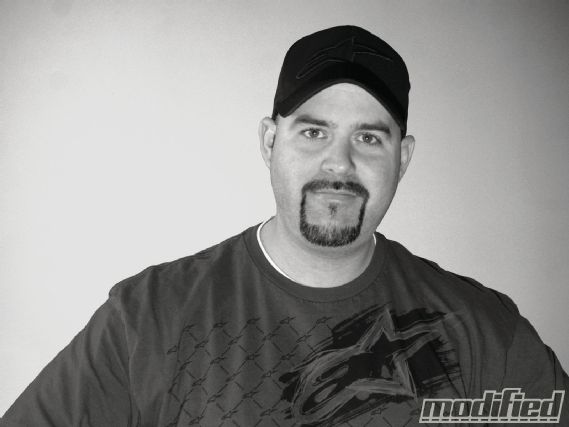 |
In The Clutch - Tech Talk
|
In The Clutch - Tech Talk
Send your feedback to [email protected]
